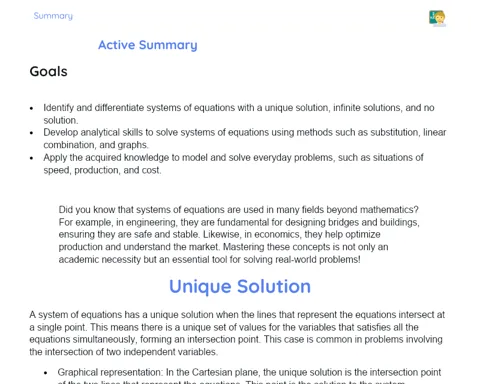Logarithms in Action: Exploring Values and Practical Applications
Objectives
1. Understand the concept of logarithm and its practical applications.
2. Calculate the value of logarithms of different bases.
3. Solve problems involving logarithm calculations, such as calculating pH and sound intensity.
Contextualization
Logarithms are used in various situations in our daily lives and are essential for understanding natural and scientific phenomena. For example, the calculation of the pH of chemical solutions, which measures the acidity or basicity of a substance, is performed using logarithms. Similarly, sound intensity, measured in decibels, uses a logarithmic scale. The Richter scale, used to measure the magnitude of earthquakes, is also based on logarithms. These concepts are widely applied in fields such as chemistry, physics, engineering, and even in the music industry.
Relevance of the Theme
Understanding and calculating logarithms is a fundamental skill not only for the study of mathematics but also for various professional areas. In today's world, where data analysis and understanding complex phenomena are increasingly important, mastery of logarithms allows for efficient solutions to practical and scientific problems. Additionally, strong mathematical skills are highly valued in the job market, opening doors to careers in science, technology, engineering, and mathematics.
Definition of Logarithm
A logarithm is the inverse operation of exponentiation. In simple terms, the logarithm of a number is the exponent to which another fixed value, the base, must be raised to produce that number. For example, in base 10 logarithm, the logarithm of 100 is 2, because 10 raised to the power of 2 is 100.
-
The logarithm of a number is the exponent to which the base must be raised to produce that number.
-
The common notation is log_b(a) = c, where b^c = a.
-
Common bases include 10 (decimal logarithm) and e (natural logarithm).
Properties of Logarithms
Logarithms have several useful properties that simplify the calculation and manipulation of mathematical expressions. Among these properties are multiplication, division, exponentiation, and root, which transform complex operations into simpler ones.
-
log_b(xy) = log_b(x) + log_b(y): Product property.
-
log_b(x/y) = log_b(x) - log_b(y): Quotient property.
-
log_b(x^y) = y * log_b(x): Power property.
-
log_b(1) = 0 and log_b(b) = 1.
Calculating Logarithms
Calculating logarithms involves finding the exponent needed for a specific base to produce a given number. This calculation is fundamental in solving problems in various scientific and engineering fields. Scientific calculators and mathematical software often include functions to calculate logarithms of different bases.
-
Calculation of logarithms in base 10 and base e (natural logarithm).
-
Use of scientific calculators to find logarithmic values.
-
Application of the concept in solving real problems, such as pH and sound intensity.
Practical Applications
- Calculation of pH of chemical solutions in laboratories and pharmaceutical industries.
- Measurement of sound intensity in decibels for acoustic and sound engineering projects.
- Assessment of the magnitude of earthquakes using the Richter scale in geology and civil engineering.
Key Terms
-
Logarithm: Inverse operation of exponentiation, used to find the exponent needed for a specific base to produce a given number.
-
Base (b): The fixed value that is raised to an exponent to calculate the logarithm.
-
Natural Logarithm (ln): Logarithm with base e, where e is approximately 2.718.
-
pH: Measure of the acidity or basicity of a solution, calculated as the negative logarithm of the concentration of H+ ions.
-
Decibels (dB): Unit of measurement for sound intensity, based on a logarithmic scale.
-
Richter Scale: Logarithmic scale used to measure the magnitude of earthquakes.
Questions
-
How are logarithms used in different professional areas and how can this impact your future career?
-
In what way can knowledge of logarithms help solve everyday and scientific problems?
-
What challenges did you face when applying the concept of logarithm in practical situations and how did you overcome those challenges?
Conclusion
To Reflect
Logarithms are more than just a simple mathematical operation; they are powerful tools that help us understand and quantify complex phenomena in the world around us. From measuring the pH of substances to assessing sound intensity and the magnitude of earthquakes, logarithms play a crucial role in various scientific and professional fields. Understanding how to calculate and apply logarithms not only enriches our mathematical knowledge but also opens doors to numerous opportunities in the job market and in solving everyday problems. As you reflect on today's learning, think about how these skills can be applied in your future career and in everyday situations that require precise and logical analysis.
Mini Challenge - Practical Challenge: Exploring the pH of Solutions
In this mini-challenge, you will build a homemade pH meter and calculate the pH of different solutions using the concept of logarithms.
- Gather the necessary materials: pH indicator paper, solutions of different pH (water, lemon juice, diluted lye, etc.), tables to record results.
- Divide into groups of 3 to 4 people.
- Measure the pH of each solution using the indicator paper and record the values in your tables.
- Calculate the concentration of H+ ions for each solution using the pH formula: pH = -log[H+].
- Present your results and discuss as a group how the concept of logarithm was used to determine the pH of the solutions.



